Diplomatic Bluebook 2019
Chapter 2
Japan's Foreign Policy that Takes a Panoramic Perspective of the World Map
3 China / Mongolia, etc.
(1) China
A The Situation in China
(A) Domestic affairs
The first session of the 13th National People's Congress (NPC) and the first session of the 13th Chinese People's Political Consultative Conference (CPPCC) National Committee were held in March, and the personnel of the State Council, NPC, and CPPCC of the second Xi Jinping administration based on the party personnel in autumn 2017 was announced. President Xi Jinping (first in the internal party hierarchy) and Premier of the State Council Li Keqiang (second in the internal party hierarchy) were reelected, while Chairperson of the Standing Committee of the NPC (NPC SC) Li Zhanshu (third in the internal party hierarchy), Chairperson of the CPPCC Wang Yang (fourth in the internal party hierarchy), and others were newly appointed. Mr. Wang Qishan, who had retired from the Standing Committee of the Central Political Bureau (PSC) (the so-called “top seven”), was elected as Vice President (it was unusual for a retired PSC member to return to public office).
At the NPC this time, the Constitution was amended for the first time in 14 years since 2004, with an addition to the Constitution of “Xi Jinping Thought on Socialism with Chinese Characteristics for a New Era” alongside former President Hu Jintao's “Scientific Outlook on Development.” In addition, the existing prohibition of third terms by presidents and vice presidents was abolished, making it possible for President Xi to maintain his position as president after 2023.
In the anti-corruption field which is actively undertaken by the Xi administration, the “National Supervision Commission” was newly established, starting an organization to crack down on corruption targeting not only members of the Communist Party of China but also all government workers.
There was reorganization of the State Council for the first time in five years since 2013, and the number of departments constituting the State Council increased from 26 to 27, including the Ministry of Natural Resources, the Ministry of Ecology and Environment, the Ministry of Agriculture and Rural Affairs, the Ministry of Culture and Tourism, the Ministry of Veterans Affairs, and the Ministry of Emergency Management.
Regarding social affairs, Ms. Liu Xia, the wife of Mr. Liu Xiaobo, a human rights activist and Nobel peace prize Laureate who died in 2017, moved to Germany in July after being released from what was essentially house arrest. The suppression of human rights activists and ethnic minorities such as the Uighurs in China continues to increase, and concerns are being raised by the international community.
(B) Economy
The real GDP growth rate in 2018 increased 6.6% year-on-year, and total trade value increased 12.6% year-on-year, which shows a slowdown in the recovery of China's economy. Due to the effects of managing issues of excess production capacity and excess debt, and trade and investment between the U.S. and China, lowered growth in domestic demand (consumption, fixed asset investment) has become visible. Trade and investment issues between the U.S. and China can also be seen in financial affairs, and stocks on the Shanghai Stock market became 25% lower at the end of the year compared to the beginning of the year. For foreign exchange rates, the trend of the drop in the value of the yuan against the US dollar continued on from the second half of the year, and although there was a change in the way of calculation of exchange rates in August, the exchange rate at the end of the year was around 6.9 yuan to the US dollar (at the beginning of the year it was 6.4 yuan to the US dollar). Based on such economic conditions, in July, the Government of China indicated that it would prop up business conditions through implementation of proactive financial policies such as infrastructure development and moderate financial policies such as provision of liquidity.
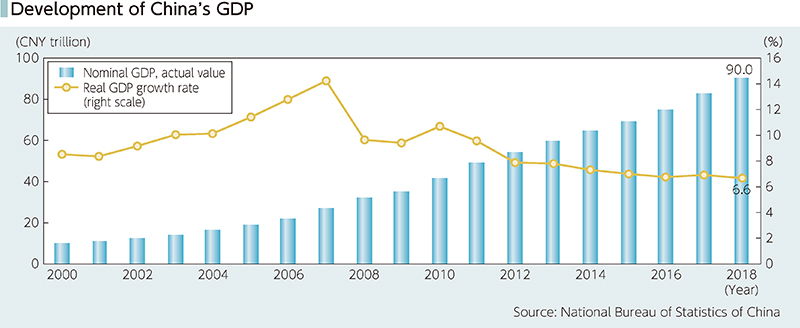
In terms of external economic policies, in 2018, the 40th anniversary of China's “reform and opening up” policy, the China International Import Expo was held and, the tariffs on vehicles, daily necessities, and other products were lowered, which are efforts toward opening up the domestic market. On the other hand, concerning the trade and investment issue between the U.S. and China, while both countries repeatedly implemented additional tariff measures on each other, attention is being paid to the trends of the discussions conducted between the countries on their future responses.
At the Central Economic Work Conference in December, with a statement that “We must see that there are new and worrisome developments amid generally steady economic operation, the external environment is complicated and severe, and the economy faces downward pressure,” there was continuation of proactive financial policies such as large-scale tax reductions as well as moderate financial policies such as resolution of the financial problem faced by private businesses and small businesses. The important tasks for 2019 were set as high-quality development of the manufacturing industry, promotion of strong domestic market formation, acceleration of economic system reform (strengthening and improvement of state-owned capital, reduction of government participation in resource allocation, etc.), promotion of general external openness, and more. In order to manage the party and administration stably, it is necessary to ensure constant economic growth and handling all domestic and external issues, and it is worth paying attention to the trends of China's future economic and financial policies.
(C) Foreign Policy
In 2018, China appealed with its “major-country diplomacy” by holding successive large-scale diplomatic events inviting leaders of countries around the world, including the Boao Forum for Asia (April), the Shanghai Cooperation Organisation Summit (June), the Forum on China-Africa Cooperation (September), and the China International Import Expo (November).
In June, the Central Conference on Work Relating to Foreign Affairs was held for the second time under the Xi administration (the previous conference was in November 2014), attended by the seven members of the PSC and Vice President Wang Qishan. Director of the Office of the Foreign Affairs Commission Yang Jiechi announced the establishment of the guiding position of the “Xi Jinping thought on diplomacy.”
In terms of U.S.-China relations, President Trump stated in his State of the Union Address at the beginning of the year that China and others are “rivals…that challenge our interests, our economy, and our values.” Since July, relations have been increasingly tense with both countries implementing retaliatory tariffs on each other. Amidst this, at the U.S.-China Summit Meeting (December) held during the G20 Buenos Aires Summit, both countries shared the view on temporarily suspending further tariff measures and holding more discussions, so their future movements are the focus of attention.
(D) Military Affairs and Security
China has been increasing its defense expenditures about 51-fold over the past 30 years, but the breakdown of the budget and the intention behind the increase has not been disclosed sufficiently. Under such circumstances, it is extensively and rapidly enhancing and modernizing its military power centered on its nuclear and missile capabilities and naval and air forces. In doing so, it is placing importance on ensuring its superiority in new domains of outer space, cyberspace, and electromagnetic waves. China's expansion of military capability lacking transparency, unilateral actions to change the status quo in the East China Sea, and expansion and activation of its military activities are common concerns in the region and international community. China has been demonstrating a proactive stance in continuing to take an active part in United Nations PKOs as well as providing various kinds of humanitarian aid and disaster support, etc.
At the 19th Party Congress, President Xi Jinping stated that China would transform its armed forces into a world-class military by the middle of this century. In recent years, China has grown to have a great influence on the international community, not only politically and economically, but also militarily. To dispel any fears of China, there is a pressing need for China to increase transparency regarding its national defense policies and military power through specific and accurate disclosure of information. Japan intends to further promote mutual trust in Japan-China relations through dialogue and people-to-people exchanges, including the Japan-China Security Dialogue, while cooperating with other countries. Japan also intends to urge China to improve its transparency and encourage its positive involvement in the international order based on the rule of law.
B Japan-China Relationship
(A) Bilateral Relations - General
The relationship with China, the neighboring country across the East China Sea, is one of Japan's most important bilateral relationships, and the two countries have close economic relations, as well as people-to-people and cultural exchanges. 2018 marked the 40th anniversary of the conclusion of the Treaty of Peace and Friendship between Japan and China, and the opportunity was taken to frequently hold high-level dialogues including Summit Meetings and Foreign Ministers' Meetings. It was a year in which Japan-China relations returned to their normal track and entered into a new stage aiming for new development.
In 2018, reciprocal visits were realized by Prime Minister Abe and Premier Li Keqiang. In May, Premier Li Keqiang paid his first official visit to Japan as Premier in eight years since 2010. At the Japan-China Summit Meeting, Premier Li Keqiang invited Prime Minister Abe to visit China within the year, and both leaders shared the view on steadily implementing high-level reciprocal visits toward the visit to Japan by President Xi Jinping. In addition, Premier Li Keqiang stated that Japan-China relations had returned to their normal track through this visit to Japan and that he wanted to maintain long-term, stable development. Prime Minister Abe stated that Japan-China relations have transitioned from competition to collaboration, and that he would like Japan and China to take major responsibilities together for various regional and global issues through development of bilateral relations. A total of 10 memoranda of cooperation have been signed, including the Maritime and Aerial Communication Mechanism between the defense authorities of Japan and China.
 Japan-China Summit Meeting with Premier Li Keqiang (May 9, Tokyo; Photo: Cabinet Public Relations Office)
Japan-China Summit Meeting with Premier Li Keqiang (May 9, Tokyo; Photo: Cabinet Public Relations Office)In October, Prime Minister Abe visited China for the first time in about seven years by a Prime Minister of Japan, with the exception of attendance at multilateral conferences. Extensive results were achieved in politics and security, foreign affairs, culture and people-to-people exchanges, and other various fields, including frank discussions on bilateral relations as well as various regional and global issues at respective summit meetings held with President Xi Jinping and Premier Li Keqiang and signing of 12 international agreements and memoranda. During Prime Minister Abe's visit to China, in addition to the summit meetings, many events were conducted such as the reception for the 40th anniversary of the Treaty of Peace and Friendship between Japan and China, and the Japan-China Forum on Third Country Business Cooperation, and an exchange between Prime Minister Abe and students from Peking University. It was thus a highly meaningful visit.
 Japan-China Summit Meeting with Premier Li Keqiang (October 26, Beijing, China; Photo: Cabinet Public Relations Office)
Japan-China Summit Meeting with Premier Li Keqiang (October 26, Beijing, China; Photo: Cabinet Public Relations Office) Japan-China Summit Meeting with President Xi Jinping (October 26, Beijing, China; Photo: Cabinet Public Relations Office)
Japan-China Summit Meeting with President Xi Jinping (October 26, Beijing, China; Photo: Cabinet Public Relations Office)Additionally, between the leaders of Japan and China, the first Japan-China Summit Telephone Talk was held with President Xi Jinping in May, and Japan-China Summit Meetings were held with President Xi Jinping in September (the Eastern Economic Forum) and November (the G20 Buenos Aires Summit).
Reciprocal visits by the foreign ministers of Japan and China were also held for the first time in nine years in 2018. Foreign Minister Kono visited China in January, and confirmed the importance of steadily realizing mutual visits by the leaders of Japan and China. State Councilor and Foreign Minister Wang Yi visited Japan in April, and a Japan-China Foreign Ministers' Meeting was held as well as the Japan-China High-Level Economic Dialogue, which was held for the first time in about eight years. In addition, continuous dialogues were held between the Foreign Ministers of Japan and China by seizing various opportunities including in August (the ASEAN-related Foreign Ministers' Meetings), September (the United Nations General Assembly), and October (Prime Minister Abe's visit to China).
On August 12, the 40th anniversary of the signing of the Treaty of Peace and Friendship between Japan and China, congratulatory telegrams were exchanged between Prime Minister Abe and Premier Li Keqiang, as well as between Foreign Minister Kono and State Councilor and Foreign Minister Wang Yi, and resolutions of deepening bilateral cooperative relations and further developing Japan-China relations were announced.
In addition to this, in February and September, Secretary-General of the National Security Secretariat Yachi visited China and met with State Councilor of the State Council Yang Jiechi, and in August, Vice-Minister for Foreign Affairs Akiba visited China and held an exchange of views with Vice Minister of Foreign Affairs Le Yucheng and others. Besides this, between the diplomatic authorities of both countries, the 2019 Memorandum on Drafting the Annual Plan on Exchanges and Cooperation between the Ministry of Foreign Affairs of Japan and the Ministry of Foreign Affairs of the People's Republic of China was signed during Prime Minister Abe's visit to China, and practical dialogue and trust-building were steadily advanced between Japan and China in each field, including the Japan-China International Law Dialogue (September), the Japan-China Counter-Terrorism Consultation (September), exchange between the Foreign Service Training Institute of Japan and China Foreign Affairs University (September), reciprocal visits by groups of mid-level officials (December), and the Japan-China Foreign Press Officials Meeting (December). Moreover, active exchanges were conducted between the legislative bodies and political parties of Japan and China. Speaker of the House of Representatives Oshima paid an official visit to China in July at the invitation of the NPC, and a joint statement was issued at the 8th meeting of the Japan-China Ruling Party Exchange Council that was held in Japan in October.
Both Japan and China share a major responsibility for the peace and stability of the region and the international community, and a stable relationship between Japan and China is essential not only to the citizens of both countries but also, for dealing with regional and international issues, including the North Korean issue. Founded on the idea of building “a Mutually Beneficial Relationship based on Common Strategic Interests” in which it is important to develop the relations of the two countries by expanding their common interests in the context of contributing together to issues of the international community, Japan will continue to implement frequent high-level reciprocal visits in a broad perspectives, and advance exchanges and cooperation in all fields, and elevate Japan-China relations to a new stage.
(B) Japan-China Economic Relations
Economic relations between Japan and China, including trade and investment, are close and interdependent. The total trade between Japan and China (excluding Hong Kong) amounted to about 317.5 billion US dollars in 2018 (6.9% increase year-on-year), and China has been the largest trading partner for Japan for 13 consecutive years. Moreover, according to Chinese statistics, Japan's direct investment in China increased to about 3.81 billion US dollars (16.5% increase year-on-year (estimated from officially published information on investment)) in 2018, due to a trend of recovery in the Chinese economy. Japan ranks fourth in terms of the amount of direct investment to China (Singapore ranks first, the ROK is second, and the UK is third).
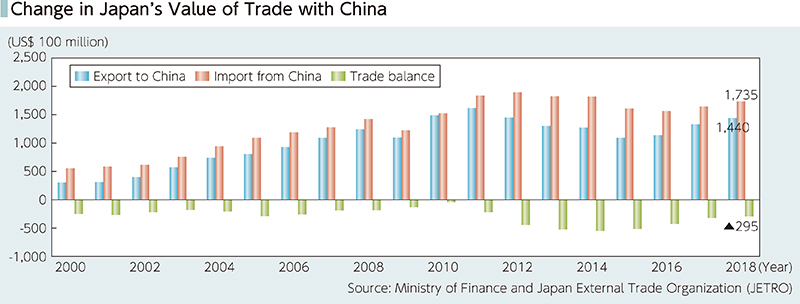

2018 marked the 40th anniversary of the conclusion of the Treaty of Peace and Friendship between Japan and China, and high-level visits and cooperative relations were also strengthened in the economic field. In April, the Japan-China High-Level Economic Dialogue was held for the first time in about eight years, during which topics as follows were discussed; regarding macroeconomic policies, cooperation and exchange in the economic field between Japan and China, cooperation between Japan and China in third countries, and economic cooperation in East Asia and responses toward global issues. During the visit to Japan by Premier Li Keqiang in May, in addition to sharing views on economic cooperation between Japan and China for finance, food products, and third countries, the “Agreement on Social Security between the Government of Japan and the Government of the People's Republic of China” (Japan-China Social Security Agreement) was signed in the presence of Prime Minister Abe and Premier Li Keqiang, and received unanimous approval at the extraordinary Diet session in November. During Prime Minister Abe's visit to China in October, finance cooperation was developed (selection of a Chinese yuan-clearing bank, conclusion and entry into force of a currency swap agreement, strengthening of cooperation between the stock markets of Japan and China), and the view was shared on creating a Japan-China Innovation Cooperation Dialogue for cooperation in the fields of innovation and intellectual property rights. In particular, Prime Minister Abe pointed out to President Xi Jinping that it is important for China to further improve on issues including intellectual property rights. In addition, the Forum on Third Country Business Cooperation was held with the participation of about 1,500 top people from the business circles of Japan and China, and 52 memoranda of cooperation concerning infrastructure, distribution, IT, and other fields were signed and exchanged. Furthermore, considering that 2018 is the 40th anniversary of China's “reform and opening up” policy, the Government of Japan ended all new ODA contributions to China as of FY2018, the view was shared on seeking a new stage of bilateral cooperation, and it was decided to proceed with coordination toward implementing dialogues and people-to-people exchanges in the development cooperation field (See Special Feature “Reflection on 40 Years of ODA to China”). Besides this, Deputy Prime Minister and Minister of Finance Aso visited China in August, and held the Japan-China Finance Dialogue with Minister of Finance Liu Kun. In addition, exchanges were implemented in broad areas, including the visit to Japan by Minister of Science and Technology Wang Zhigang in August, during which he attended the Japan-China Science and Technology Cooperation Committee, and had a meeting with Minister of Education, Culture, Sports, Science and Technology Hayashi.
In regard to food products, the Project to Support the Overseas Promotion of Regional Charms was held in Beijing and Shanghai from the end of January to the beginning of February to expand publicity business for Japanese food products centered on rice cultivated in Japan and other products. In November, the Japan-China Food Safety Promotion Initiative Ministerial Meeting was held in Tokyo for the first time in seven years, attended by State Minister of Health, Labour and Welfare Oguchi, Vice Minister Zou Zhiwu of general administration of customs, and others. In particular, regarding the import restrictions placed on food and agricultural products from Japan by the Government of China, Japan has taken every opportunity to urge Chinese side to carry out an evaluation based on scientific evidence, and has lobbied for the abolition and relaxation of the restrictions. The opportunities included the Japan-China Summit Meetings in May and October and the above-mentioned Japan-China High-Level Economic Dialogue, the 8th Japan-China Ruling Party Exchange Council in October and the meeting between top officials of the relevant authorities, i.e. Minister of Agriculture, Forestry and Fisheries Yoshikawa and Customs Commissioner-General Ni Yuefeng in November, the visit to China by Special Advisor to the Prime Minister Eto in November, the visit to China by Special Advisor to the Cabinet Nishikawa in July, and the visit to China by LDP Secretary-General Toshihiro Nikai in August. Some results were produced from this, including the announcement by the Chinese authorities of the lifting of the ban on polished rice from Niigata Prefecture at the end of November.
There were active economic exchanges also in the private sector. During the visit to China by a mission from the Japan-China Economic Association, Keidanren (Japan Business Federation) and Japan Chamber of Commerce and Industry in September, and the Japan-China Business Leader and Former High-Level Government Official Dialogue (Japan-China CEO Summit) held in Beijing in October, views were exchanged between the executives of major companies in Japan and China, and meetings were held with officials of the Government of China including Premier Li Keqiang.
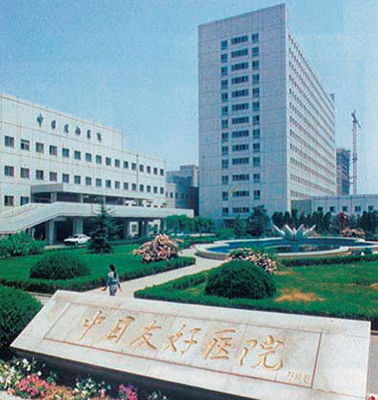 China-Japan Friendship Hospital (Beijing, China; Photo: JICA)
China-Japan Friendship Hospital (Beijing, China; Photo: JICA)In 1979, Prime Minister Ohira announced Japan's cooperation for China's modernization following the normalization of diplomatic ties between Japan and China, and China's adoption of the reform and opening-up policy. In the same year, Japan began Official Development Assistance (ODA) to China with technical cooperation for railway modernization and other areas of cooperation.
In the 1980s, Japan provided assistance with emphasis on transition to a market economy and modernization, mainly through large-scale economic infrastructure assistance with yen loans. For example, the expansion project for Qinhuangdao Port in Hebei Province turned the port into China's largest coal loading and unloading port. Additionally, the China-Japan Friendship Hospital was established as the first grant aid project to China. Since then, the hospital continued to train medical experts through technical cooperation from Japan and is a symbol of friendship between Japan and China.
In the 1990s, in addition to economic infrastructure projects, such as Shanghai Pudong International Airport and Beijing Urban Railway, Japan provided assistance toward urbanization, and countermeasures to environmental pollution and regional poverty. The Sino-Japan Friendship Centre for Environmental Protection, the establishment of which was supported by Japan's grant aid, now plays a central role in China's environmental protection efforts. Survey results show that a series of yen loan projects in environmental areas conducted from FY1996 to FY2000 benefited more than 3.95 million people in ten cities via city gas projects, more than 900,000 people in six cities via regional heat supply projects, and more than 13 million people in 28 cities via sewage projects.
 Activities by Japan's Disaster Relief Team after the major Sichuan earthquake (Sichuan Province, China; Photo: JICA)
Activities by Japan's Disaster Relief Team after the major Sichuan earthquake (Sichuan Province, China; Photo: JICA)In the 2000s, the focus of assistance shifted from economic infrastructure to areas such as environmental and ecological conservation, social development, human resource development, and legal system establishment, and the scale of ODA to China contracted from a peak of 214.4 billion yen in FY2000. Specifically, ODA steadily contributed to afforestation projects in 13 provinces and autonomous regions, establishing pension systems in rural areas, fostering the business environment, and developing a legal framework to support Japanese companies' entry into Chinese market. However, Japan concluded general grant aid and new yen loan provision to China in 2006 and in 2007 respectively in light of China's advancement. In addition, the media in Japan and China extensively covered assistance by Japan's Disaster Relief Team after the major Sichuan earthquake in 2008.
These assistance helped support and promote China's reform and opening-up policy, while also forming a robust foundation as a major pillar underpinning Japan-China relations.
In recent years, through technical cooperation projects and other assistance, Japan has provided assistance only to areas which truly require assistance such as cross-border pollution and infectious diseases that directly benefit the Japanese people. On the occasion of Prime Minister Abe's visit to China in October 2018, he announced the conclusion of ODA to China, which totaled approximately 3.6 trillion yen including loan aid and grant aid on the occasion of the 40th anniversary of China's reform and opening-up policy from a perspective of promoting a new era of Japan-China cooperation as equal partners. Chinese President Xi Jinping expressed his great appreciation for Japan's past assistance. In the coming future, the governments of Japan and China will hold discussions to materialize new forms of cooperation between the two countries, such as dialogue and people-to-people exchanges in the area of development policy.
(C) Promotion of Mutual Understanding Between Japanese and Chinese People
(Current situation of people-to-people exchanges between Japan and China)
The number of Chinese visitors to Japan has continued to increase since 2013. The number of visitors in 2017 reached around 7.36 million people (estimated by the Japan National Tourism Organization (JNTO)), which was a new record. In 2017, over 10 million people from Japan and China visited the other country throughout the year. There was a further shift from group tourism to individual tourism, and there was also an increase in the number of repeat visitors as a result of relaxed visa requirements. It is thought that this is leading to diversification of the destinations and needs of visitors to Japan.
(Japan-China youth exchange, etc.)
During Prime Minister Abe's visit to China in October, he and Premier Li Keqiang shared the recognition that it is necessary to further expand people-to-people exchanges between Japan and China, particularly exchanges among the young generation, from the perspective of fostering mutual trust and understanding among the people of both countries. In addition, the foreign ministers of Japan and China signed the “Memorandum on Enhancing Youth Exchange between the Government of Japan and the Government of the People's Republic of China,” 2019 was designated as “Japan-China Youth Exchange Promotion Year,” and shared the view on implementing young exchanges on a scale of 30,000 people over the following five years.
In 2018, through JENESYS2018, the people-to-people exchange project including young people, about 800 Chinese people, including high school students and young adults, were invited to Japan. Young Chinese people who visited Japan experienced various cultures, lifestyles and the charms of Japan through school exchanges and tours of companies, while deepening mutual understanding with Japanese youth. They also actively exchanged opinions about what the future of Japan-China relations should be. Furthermore, under the Japan-China International Solidarity Project on Afforestation and Tree-Planting, a thousand or so people were invited to the exchange event for promoting understanding of Japan based on the theme of the “Three KAKEHASHI (Bridge)” Projects ((1) University exchanges, (2) Olympic and Paralympic exchanges, and (3) Soccer exchanges).
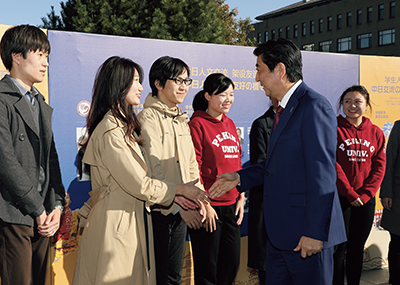 Prime Minister Abe interacting with university students at Peking University (October 26, Beijing, China; Photo: Cabinet Public Relations Office)
Prime Minister Abe interacting with university students at Peking University (October 26, Beijing, China; Photo: Cabinet Public Relations Office) Welcome reception for Premier Li Keqiang hosted by the Executive Committee for Promotion of Japan-China Exchange (May 10, Tokyo; Photo: Keidanren)
Welcome reception for Premier Li Keqiang hosted by the Executive Committee for Promotion of Japan-China Exchange (May 10, Tokyo; Photo: Keidanren) The Japan-China 500-University Student Delegation at the Japan-China University Student Exchange Ceremony and Networking Dinner marking the 40th anniversary of the Treaty of Peace and Friendship between Japan and China (November 30, Tokyo; Photo: Japan-China Friendship Center)
The Japan-China 500-University Student Delegation at the Japan-China University Student Exchange Ceremony and Networking Dinner marking the 40th anniversary of the Treaty of Peace and Friendship between Japan and China (November 30, Tokyo; Photo: Japan-China Friendship Center)(Exchanges in various fields)
To develop Japan-China stable relations that will continue in the future, the Government of Japan endeavors to invite people at various levels from all walks of life to Japan, such as people who have certain influence in the political, economic, public and academic sectors, and opinion leaders, in addition to young people who will carry the next generation, such as high school students and university students, thereby making efforts for a wide range of relationship building and strengthening. Through exchanges including the exchanging of views with various circles and experts in Japan, and inspection tours, it is expected that good relationships will be built between the participants, promoting a more accurate understanding of Japan.
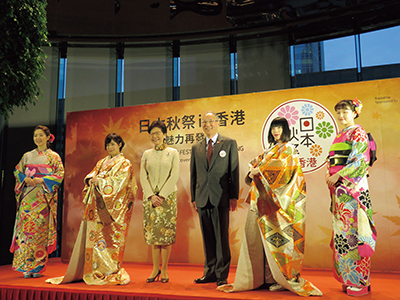 Opening ceremony of “Japan Autumn Festival in HK: Rediscovering Nippon” held with attendance of Chief Executive of the Hong Kong SAR Carrie Lam (third from left) (October 12, Hong Kong)
Opening ceremony of “Japan Autumn Festival in HK: Rediscovering Nippon” held with attendance of Chief Executive of the Hong Kong SAR Carrie Lam (third from left) (October 12, Hong Kong)Furthermore, in 2018, which is the 40th anniversary of the conclusion of the Treaty of Peace and Friendship between Japan and China, with the cooperation of the Executive Committee for Promotion of Exchanges for the 45th Anniversary of the Normalization of Japan-China Diplomatic Relations and the 40th Anniversary of the Conclusion of the Treaty of Peace and Friendship between Japan and China (the Executive Committee for Promotion of Japan-China Exchange), over 440 approved events were held throughout the year including a variety of exchange programs, promoting friendly cooperative relations.
(D) Specific Pending Issues
(Situation surrounding the East China Sea)
In the East China Sea, Chinese Government-owned vessels continue to intrude into Japanese territorial waters around the Senkaku Islands. Also, the Chinese military has been rapidly expanding and increasing its activities in quality and quantity at sea and in the airspace over the East China sea. Furthermore, China continues unilateral development of resources in the maritime area pending delimitation between Japan and China, and has repeatedly carried out maritime surveys without Japan's consent.
The Senkaku Islands are indisputably an inherent part of the territory of Japan in light of historical facts and based upon international law. Indeed, the Senkaku Islands are under the valid control of Japan. Thus, there exists no issue of territorial sovereignty to be resolved concerning the Senkaku Islands. From 1895, when Japan obtained territorial title over the Senkaku Islands by lawful means under international law, until the 1970s, when the islands became the focus of attention after it was suggested that there might be oil reserves in the East China Sea, China had not raised any objections to Japan's sovereignty over the Senkaku Islands. Moreover, China has never explained why it had not expressed objections until then.
Regarding the trends in the presence of Chinese Government-owned vessels and fishing boats in the waters around the Senkaku Islands, Chinese Government-owned vessels continue to intrude into Japanese territorial waters, recording 19 incidents during the year (the numbers were 29 in 2017, and 36 in 2016). In response to such unilateral attempts by China to change the status quo, the Government of Japan has repeatedly lodged strong protests and requested the withdrawal of Chinese vessels through diplomatic routes. With the determination to defend Japan's territorial land, sea and airspace, Japan will deal with the situation with resolute and calm determination.
In addition, Chinese naval vessels and aircraft have also been accelerating their activities in the sea and airspace around Japan. In January, a submarine and ship navigated into Japan's contiguous zone around the Senkaku Islands, and in June, a Chinese Navy hospital ship navigated into the same contiguous zone. We expressed serious concerns, issued a severe protest, and strongly requested that it would not happen again, through diplomatic routes. Furthermore, aircraft activity also continues to be active, and the number of times the Air Self-Defense Force had to scramble jets in response to Chinese military aircraft since autumn 2012 has remained high. In response to these recent activities by the Chinese military, Japan has been raising the issues in an appropriate manner through diplomatic routes.
Furthermore, China has continued its unilateral activities to develop natural resources in the Exclusive Economic Zone (EEZ) between Japan and China and the continental shelf that have not yet been delimited in the East China Sea. The Government of Japan has confirmed 12 new structures built between June 2013 and May 2016, making a total of 16 structures including those confirmed before then, on the Chinese side of the geographical equidistance line. Such unilateral development actions are extremely regrettable, and every time such moves by China are recognized, Japan has strongly requested China to cease its unilateral development and to resume negotiations as soon as possible on the implementation of the “2008 Agreement” regarding the cooperation between Japan and China on the development of natural resources in the East China Sea. During Prime Minister Abe's visit to China in October 2018, both countries reaffirmed the complete adherence to the “2008 Agreement” regarding the development of resources in the East China Sea, and shared the view that they will increase communication with the aim for an early resumption of negotiations to implement the agreement.
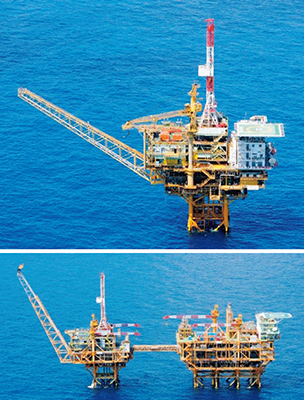 A Chinese maritime structure confirmed to have been built near the geographical equidistant line between Japan and China (Photo: Ministry of Defense)
A Chinese maritime structure confirmed to have been built near the geographical equidistant line between Japan and China (Photo: Ministry of Defense)See the link below for details: https://www.mofa.go.jp/mofaj/area/china/higashi_shina/tachiba.html
Moreover, in recent years numerous activities by China to carry out surveys in the waters around Japan, including the East China Sea, without obtaining Japan's approval, or surveys that differ from those agreed upon have been confirmed.
In order to deal with these concerns appropriately, both Japan and China have been promoting dialogue and exchanges between the authorities concerned. During the visit to Japan by Premier Li Keqiang in May, the discussions on the Maritime and Aerial Communication Mechanism between the defense authorities of Japan and China had been conducted after ten years of consultations, and in June the Mechanism began to be utilized. This is highly significant for promoting mutual understanding between both countries and avoiding and preventing accidental collisions. In December, the first Annual and Experts Meeting based on the Maritime and Aerial Communication Mechanism between the defense authorities was held. Also, during Prime Minister Abe's visit to China, the Japan-China Maritime Search and Rescue (SAR) Agreement was signed. The Agreement creates a legal framework regarding Japan-China cooperation for the maritime search and rescue field, and is expected to enable smoother and more efficient search and rescue activities. In addition, in April and December, meetings of the Japan-China High-Level Consultation on Maritime Affairs were respectively held in Sendai and Wuzhen, Jiaxing City, Zhejiang Province.
As Prime Minister Abe has repeatedly stated at Japan-China Summit Meetings, true improvement in Japan-China relations cannot be achieved without stability in the East China Sea. It is highly meaningful from the perspective of building trust and bolstering cooperation for diplomats from both countries to meet in person and exchange opinions frankly, such as at the Japan-China High-Level Consultation on Maritime Affairs Round Meetings or other discussions between related authorities of both countries. The Government of Japan will strive to improve relations with China, while asserting Japan's position on individual issues through steady dialogue and continued bolstering of communication, in an effort to turn the East China Sea into the “Sea of Peace, Cooperation and Friendship.”
(Abandoned chemical weapons issue)
The Government of Japan, in accordance with the Chemical Weapons Convention (CWC), has been working on the destruction of chemical weapons abandoned by Japan in China. In 2018, on site investigations, and excavation and recovery operations were carried out in various locations across China. The destruction works in Haerbaling District in Dunhua, Jilin Province also have been carried out. In total, about 52,000 abandoned chemical weapons have been destroyed as of December 2018.
(Cases of Detainment of Japanese Nationals)
In regard to cases of detainment of Japanese nationals, the Government of Japan requests the Government of China to ensure transparency in executing the law and the judicial process, properly safeguard the rights of Japanese nationals, ensure impartial justice, and provide humane treatment.
(2) Taiwan
A Internal Affairs
The once-every-four-year local elections were held on November 24. The ruling Democratic Progressive Party (DPP) was severely defeated losing half its mayor post, and the opposition Kuomintang party more than doubled its number of mayors and won. After the elections, President Tsai Ing-wen resigned as Chairperson of the DPP. In addition, the real GDP growth rate in 2018 increased by 2.63% year-on-year.
B Cross-strait Relations and Foreign Affairs
Since the inauguration of the Tsai Ing-wen administration, it can be seen that the direct cross-strait exchanges through the official route (Chinese side: the Association for Relations Across the Taiwan Strait, Taiwan Affairs Office; Taiwan side: the Straits Exchange Foundation, Mainland Affairs Council) have been discontinued. Moreover, Taiwan was unable to attend meetings held by international organizations and others, including meetings organized by World Health Organization (WHO), due to opposition from China. The Dominican Republic and Burkina Faso severed relations with Taiwan and established diplomatic relations with China in May, and El Salvador did the same in August, decreasing the number of countries with diplomatic ties with Taiwan to 17.
C Japan-Taiwan Relationship
For Japan, Taiwan is a crucial partner and an important friend, with which it shares fundamental values such as freedom, democracy, basic human rights, and the rule of law, and enjoys close economic relations and people-to-people exchanges. The relationship between Japan and Taiwan is maintained on the basis of working relations at the non-governmental level in accordance with the 1972 Joint Communiqué between Japan and China. In November, five cooperation documents between the Japan-Taiwan Exchange Association and the Taiwan-Japan Relations Association were signed. Then the 3rd dialogue on maritime cooperation was held in December, and two memoranda of cooperation were signed.
On the other hand, Taiwan has continued to impose import restrictions on Japanese food products after the Great East Japan Earthquake, and Japan has repeatedly strongly requested the removal and relaxation of the restrictions on the basis of scientific evidence.
(3) Mongolia
A Domestic Affairs
Prime Minister Khurelsukh, who was elected Prime Minister in October 2017 and Chairman of the ruling Mongolian People's Party in November 2017, has made efforts to steadily implement the Extended Fund Facility (EFF) agreed upon with the International Monetary Fund (IMF). Results include the real GDP growth rate reaching 6.4% for the January-September 2018 period, creating a shift to steady improvement of Mongolia's macroeconomic indicators.
B Japan-Mongolia Relations
Mongolia is an important regional partner sharing universal values with Japan, so Japan will continue to strengthen friendly ties with the country in a “Strategic Partnership,” so that the relationship will truly be mutually beneficial.
High-level exchanges were actively held between the Government of Japan and the Government of Mongolia in 2018, including the Foreign Ministers' Meeting in February (Tokyo), the third Japan-Mongolia Strategic Dialogue in April (Tokyo), the Summit Meeting between Prime Minister Abe and President Battulga in September (Vladivostok, Russia), and the Summit Meeting between Prime Minister Abe and Prime Minister Khurelsukh in December (Tokyo). In addition, as for multilateral dialogues, the 3rd Japan-U.S.-Mongolia Trilateral Dialogue was held in April (Tokyo), and Special Advisor to the Prime Minister Sonoura visited Mongolia in August to attend the completion ceremony for capacity building support implemented by the Ministry of Defense.
 Japan-Mongolia Summit Meeting (September 11, Vladivostok, Russia; Photo: Cabinet Public Relations Office)
Japan-Mongolia Summit Meeting (September 11, Vladivostok, Russia; Photo: Cabinet Public Relations Office)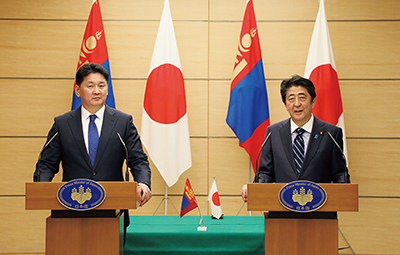 Joint press announcement following the Japan-Mongolia Summit Meeting (December 13, Tokyo; Photo: Cabinet Public Relations Office)
Joint press announcement following the Japan-Mongolia Summit Meeting (December 13, Tokyo; Photo: Cabinet Public Relations Office) Japan-Mongolia Foreign Ministers' Meeting (February 22, Tokyo; Photo: Cabinet Public Relations Office)
Japan-Mongolia Foreign Ministers' Meeting (February 22, Tokyo; Photo: Cabinet Public Relations Office)Between the legislative bodies, after the visit to Japan by Deputy Speaker of State Great Hural (Parliament) of Mongolia Enkh-Amgalan in June, Vice President of the House of Councillors Gunji visited Mongolia in October. Following on from reciprocal visits by Chairman of State Great Hural (Parliament) of Mongolia Enkhbold and Speaker of the House of Representatives Oshima last year, reciprocal visits by the vice presidents of the legislative bodies were implemented to further strengthen mutual exchanges.
Following the Japan-Mongolia Summit Meeting held during the visit to Japan by Prime Minister Khurelsukh in December, both leaders announced a joint statement and issued a fact sheet confirming the status of progress of the “Japan-Mongolia Mid-term Action Plan for a Strategic Partnership (2017-2021) “signed by the foreign ministers in March 2017. Japan will continue to strengthen bilateral relations steadily in accordance with the Plan and make efforts to develop the “Strategic Partnership” between Japan and Mongolia.

